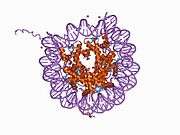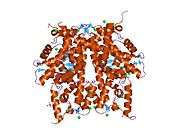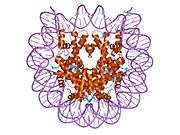H2AFX
H2AFX (H2A histone family, member X) is one of several genes coding for histone H2A. In humans and other eukaryotes, the DNA is wrapped around histone-groups, consisting of core histones H2A, H2B, H3 and H4. Thus, the H2AX contributes to the nucleosome-formation and therefore the structure of DNA.
H2AX becomes phosphorylated on serine 139, then called gamma-H2AX, as a reaction on DNA Double-strand breaks (DSB). The kinases of the PI3-family (Ataxia telangiectasia mutated, ATR and DNA-PKcs) are responsible for this phosphorylation, especially ATM. The modification can happen accidentally during replication fork collapse or in the response to ionizing radiation but also during controlled physiological processes such as V(D)J recombination. Gamma-H2AX is a sensitive target for looking at DSBs in cells. The role of the phosphorylated form of the histone in DNA repair is under discussion but it is known that because of the modification the DNA becomes less condensed, potentially allowing space for the recruitment of proteins necessary during repair of DSBs. Mutagenesis experiments have shown that the modification is necessary for the proper formation of ionizing radiation induced foci in response to double strand breaks, but is not required for the recruitment of proteins to the site of DSBs.
Interactions
H2AX has been shown to interact with:
References
- 1 2 Mallery DL, Vandenberg CJ, Hiom K (Dec 2002). "Activation of the E3 ligase function of the BRCA1/BARD1 complex by polyubiquitin chains". The EMBO Journal. 21 (24): 6755–62. doi:10.1093/emboj/cdf691. PMC 139111
 . PMID 12485996.
. PMID 12485996. - 1 2 Chen A, Kleiman FE, Manley JL, Ouchi T, Pan ZQ (Jun 2002). "Autoubiquitination of the BRCA1*BARD1 RING ubiquitin ligase". The Journal of Biological Chemistry. 277 (24): 22085–92. doi:10.1074/jbc.M201252200. PMID 11927591.
- ↑ Paull TT, Rogakou EP, Yamazaki V, Kirchgessner CU, Gellert M, Bonner WM. "A critical role for histone H2AX in recruitment of repair factors to nuclear foci after DNA damage". Current Biology. 10 (15): 886–95. doi:10.1016/s0960-9822(00)00610-2. PMID 10959836.
- 1 2 Sengupta S, Robles AI, Linke SP, Sinogeeva NI, Zhang R, Pedeux R, Ward IM, Celeste A, Nussenzweig A, Chen J, Halazonetis TD, Harris CC (Sep 2004). "Functional interaction between BLM helicase and 53BP1 in a Chk1-mediated pathway during S-phase arrest". The Journal of Cell Biology. 166 (6): 801–13. doi:10.1083/jcb.200405128. PMC 2172115
 . PMID 15364958.
. PMID 15364958. - ↑ Stewart GS, Wang B, Bignell CR, Taylor AM, Elledge SJ (Feb 2003). "MDC1 is a mediator of the mammalian DNA damage checkpoint". Nature. 421 (6926): 961–6. doi:10.1038/nature01446. PMID 12607005.
- ↑ Xu X, Stern DF (Oct 2003). "NFBD1/MDC1 regulates ionizing radiation-induced focus formation by DNA checkpoint signaling and repair factors". FASEB Journal. 17 (13): 1842–8. doi:10.1096/fj.03-0310com. PMID 14519663.
- ↑ Kobayashi J, Tauchi H, Sakamoto S, Nakamura A, Morishima K, Matsuura S, Kobayashi T, Tamai K, Tanimoto K, Komatsu K (Oct 2002). "NBS1 localizes to gamma-H2AX foci through interaction with the FHA/BRCT domain". Current Biology. 12 (21): 1846–51. doi:10.1016/s0960-9822(02)01259-9. PMID 12419185.
- ↑ Fernandez-Capetillo O, Chen HT, Celeste A, Ward I, Romanienko PJ, Morales JC, Naka K, Xia Z, Camerini-Otero RD, Motoyama N, Carpenter PB, Bonner WM, Chen J, Nussenzweig A (Dec 2002). "DNA damage-induced G2-M checkpoint activation by histone H2AX and 53BP1". Nature Cell Biology. 4 (12): 993–7. doi:10.1038/ncb884. PMID 12447390.
- ↑ Ward IM, Minn K, Jorda KG, Chen J (May 2003). "Accumulation of checkpoint protein 53BP1 at DNA breaks involves its binding to phosphorylated histone H2AX". The Journal of Biological Chemistry. 278 (22): 19579–82. doi:10.1074/jbc.C300117200. PMID 12697768.
Further reading
- Redon C, Pilch D, Rogakou E, Sedelnikova O, Newrock K, Bonner W (Apr 2002). "Histone H2A variants H2AX and H2AZ". Current Opinion in Genetics & Development. 12 (2): 162–9. doi:10.1016/S0959-437X(02)00282-4. PMID 11893489.
- Fernandez-Capetillo O, Lee A, Nussenzweig M, Nussenzweig A (2005). "H2AX: the histone guardian of the genome". DNA Repair. 3 (8-9): 959–67. doi:10.1016/j.dnarep.2004.03.024. PMID 15279782.
- Mannironi C, Bonner WM, Hatch CL (Nov 1989). "H2A.X. a histone isoprotein with a conserved C-terminal sequence, is encoded by a novel mRNA with both DNA replication type and polyA 3' processing signals". Nucleic Acids Research. 17 (22): 9113–26. doi:10.1093/nar/17.22.9113. PMC 335118
 . PMID 2587254.
. PMID 2587254. - Banerjee S, Smallwood A, Hultén M (Feb 1995). "ATP-dependent reorganization of human sperm nuclear chromatin". Journal of Cell Science. 108 (2): 755–65. PMID 7769017.
- Ivanova VS, Hatch CL, Bonner WM (Sep 1994). "Characterization of the human histone H2A.X gene. Comparison of its promoter with other H2A gene promoters". The Journal of Biological Chemistry. 269 (39): 24189–94. PMID 7929075.
- Ivanova VS, Zimonjic D, Popescu N, Bonner WM (Sep 1994). "Chromosomal localization of the human histone H2A.X gene to 11q23.2-q23.3 by fluorescence in situ hybridization". Human Genetics. 94 (3): 303–6. doi:10.1007/BF00208289. PMID 8076949.
- Rogakou EP, Pilch DR, Orr AH, Ivanova VS, Bonner WM (Mar 1998). "DNA double-stranded breaks induce histone H2AX phosphorylation on serine 139". The Journal of Biological Chemistry. 273 (10): 5858–68. doi:10.1074/jbc.273.10.5858. PMID 9488723.
- El Kharroubi A, Piras G, Zensen R, Martin MA (May 1998). "Transcriptional activation of the integrated chromatin-associated human immunodeficiency virus type 1 promoter". Molecular and Cellular Biology. 18 (5): 2535–44. doi:10.1128/mcb.18.5.2535. PMC 110633
 . PMID 9566873.
. PMID 9566873. - Rogakou EP, Boon C, Redon C, Bonner WM (Sep 1999). "Megabase chromatin domains involved in DNA double-strand breaks in vivo". The Journal of Cell Biology. 146 (5): 905–16. doi:10.1083/jcb.146.5.905. PMC 2169482
 . PMID 10477747.
. PMID 10477747. - Rogakou EP, Nieves-Neira W, Boon C, Pommier Y, Bonner WM (Mar 2000). "Initiation of DNA fragmentation during apoptosis induces phosphorylation of H2AX histone at serine 139". The Journal of Biological Chemistry. 275 (13): 9390–5. doi:10.1074/jbc.275.13.9390. PMID 10734083.
- Paull TT, Rogakou EP, Yamazaki V, Kirchgessner CU, Gellert M, Bonner WM (2001). "A critical role for histone H2AX in recruitment of repair factors to nuclear foci after DNA damage". Current Biology. 10 (15): 886–95. doi:10.1016/S0960-9822(00)00610-2. PMID 10959836.
- Deng L, de la Fuente C, Fu P, Wang L, Donnelly R, Wade JD, Lambert P, Li H, Lee CG, Kashanchi F (Nov 2000). "Acetylation of HIV-1 Tat by CBP/P300 increases transcription of integrated HIV-1 genome and enhances binding to core histones". Virology. 277 (2): 278–95. doi:10.1006/viro.2000.0593. PMID 11080476.
- Chen HT, Bhandoola A, Difilippantonio MJ, Zhu J, Brown MJ, Tai X, Rogakou EP, Brotz TM, Bonner WM, Ried T, Nussenzweig A (Dec 2000). "Response to RAG-mediated VDJ cleavage by NBS1 and gamma-H2AX". Science. 290 (5498): 1962–5. doi:10.1126/science.290.5498.1962. PMID 11110662.
- Chadwick BP, Willard HF (May 2001). "Histone H2A variants and the inactive X chromosome: identification of a second macroH2A variant". Human Molecular Genetics. 10 (10): 1101–13. doi:10.1093/hmg/10.10.1101. PMID 11331621.
- Burma S, Chen BP, Murphy M, Kurimasa A, Chen DJ (Nov 2001). "ATM phosphorylates histone H2AX in response to DNA double-strand breaks". The Journal of Biological Chemistry. 276 (45): 42462–7. doi:10.1074/jbc.C100466200. PMID 11571274.
- Ward IM, Chen J (Dec 2001). "Histone H2AX is phosphorylated in an ATR-dependent manner in response to replicational stress". The Journal of Biological Chemistry. 276 (51): 47759–62. doi:10.1074/jbc.C100569200. PMID 11673449.
- Deng L, Wang D, de la Fuente C, Wang L, Li H, Lee CG, Donnelly R, Wade JD, Lambert P, Kashanchi F (Oct 2001). "Enhancement of the p300 HAT activity by HIV-1 Tat on chromatin DNA". Virology. 289 (2): 312–26. doi:10.1006/viro.2001.1129. PMID 11689053.
- Chen A, Kleiman FE, Manley JL, Ouchi T, Pan ZQ (Jun 2002). "Autoubiquitination of the BRCA1*BARD1 RING ubiquitin ligase". The Journal of Biological Chemistry. 277 (24): 22085–92. doi:10.1074/jbc.M201252200. PMID 11927591.
- Zhu H, Hunter TC, Pan S, Yau PM, Bradbury EM, Chen X (Apr 2002). "Residue-specific mass signatures for the efficient detection of protein modifications by mass spectrometry". Analytical Chemistry. 74 (7): 1687–94. doi:10.1021/ac010853p. PMID 12033261.












